I’d like, if anyone would be willing to help me, to fairly evaluate a specific set of initial assumptions for an attack on the Z32.
Thoughts on the viability and/or potential of the following as a starting point would be very helpful, and welcomed.
Of the figures below, the first merely shows the Z32 with some additional colour coding. Red shows the cipher characters that are present in the Z13 also. The remaining three colours are set merely to highlight where the duplicates of the 32 occur.
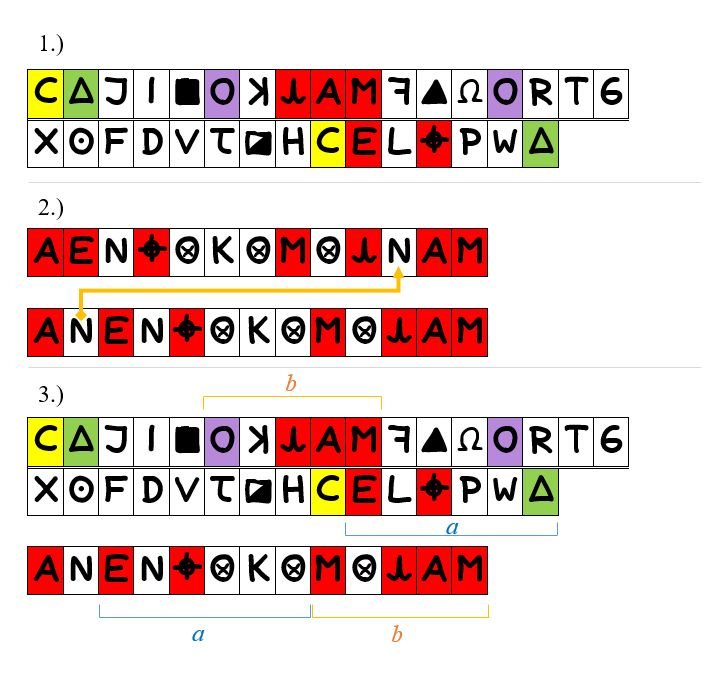
The second figure starts with the Z13 as we are familiar with it. Here I have chosen only to highlight the common characters across this and the 32.
So, for a beginning. When focussing in on the two ‘groupings’ of the common characters from the 13 in the 32, it is my contention that some striking and notable features immediately jump out that can be taken to suggest not only the possibility of there being a common key across the two ciphers, but potentially even some actual common words.
This latter potential would appear even more strongly, if it was not for the interloping ‘N’ at the 11th position in the 13.
I’ve been exploring the idea of elevating the above idea from ‘suggested’ (i.e., possibly indicated) to assumed — that the occurrence and choice of the common characters, including their setting in the Z32, is intentional and provided as an aid to the solution of the latter. With this assumed, the plan of attack thus becomes to approach solution through working across the two ciphers in tandem.
With that in mind, I would want to fix one potential early deduction from the assumption of common words: that the seemingly stray ‘N’ mentioned above is likewise intentionally displaced from its actual lexical position at (most plausibly) 2, as per the lower half of the second figure. The offered rationale for this is that this shift alone would produce all the striking symmetries that we can readily note in the 13, with only one added level of obfuscation, and that the compiler of the 13 would likely enjoy this little ruse.
From the assumptions above, then, the first proposal would be that each of the two pairings of lettered n-grams in the third figure are investigated as comprising the same word in both ciphers.
Even just at the assumptions stage, as here, the underlying premise is then that the Z13 be investigated as nothing other than a prototype of the Z32, in the sense that the intention of both is to convey the exact same message — that is, the location of the Zodiac’s bomb.
“This isn’t right! It’s not even wrong!”—Wolfgang Pauli (1900–1958)
I would totally agree, Traveller. And I think, from my point of view, what is perhaps the most compelling thing about the starting assumptions that I have proposed is that, right from the outset, they are tightly limiting and get you going at a pace.
Let me run through a quick example.
I have little trouble believing that the beginning of the Z32 will be a number that starts, or even wholly comprises, the specification of a bearing from Mount Diablo. This seems the most probable beginning, for me.
So, what if I suggest as a first ‘guess’ that this number is ‘EIGHT’, just as an example. What does that get us?
Well, just from this beginning we would have already bagged the ‘8-balls’ in the 13. And that, in turn, feeds back into the 7th character of the 32 and the 3rd from the end.

It’s kind of like you have this crossed- or parallel-solving going on.
So it does appear that the given (I think reasonable) assumptions have the capacity to be pretty powerful and incisive when applied.
But, of course, this is only helpful if the assumptions themselves stand up.
“This isn’t right! It’s not even wrong!”—Wolfgang Pauli (1900–1958)
So, what if I suggest as a first ‘guess’ that this number is ‘EIGHT’, just as an example. What does that get us?
And, as it turns out, ‘EIGHT’ is a pretty reasonable number to trial first, if only for the fact that eight of whatever you want to think of as the divisions indicated by the numbering around the Diablo rose (plus adjustment of 17 degrees for magnetic declination) defines a direction that carries you right over to the heart of the City of San Francisco which, coupled with the distance to be deciphered (see later), is probably enough, if we find that something additional and identifying is given also. The Zodiac was heavily taunting the SFPD at the time of his bomb threats, and subsequently. Thus it would seem reasonable to propose that the most likely location for the Zodiac’s bomb would be somewhere within the bounds of the City.
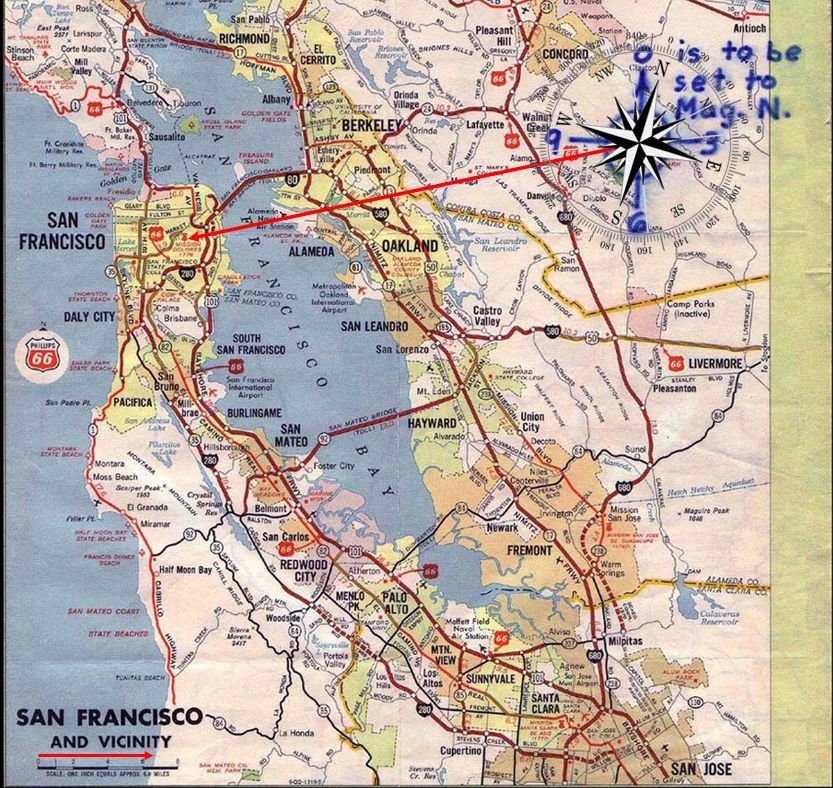
“This isn’t right! It’s not even wrong!”—Wolfgang Pauli (1900–1958)
I suppose that the next plausible consideration would then be that the second element of the Z32 cipher gives a name for these divisions (units) of the full 360 into 12th parts of 30 degrees each. But what would we call these? Following this through logically in line with the initial assumptions, the plural of this unit name will be a five letter word that must also have its first letter the same as its last, with second letter ‘I’. Written around a symbol that represents the persona of ‘the Zodiac’, the following would surely have to be given foremost candidate status: ‘SIGNS’.

“This isn’t right! It’s not even wrong!”—Wolfgang Pauli (1900–1958)
Indeed, to continue the same theme, although possibly prematurely I would already be liking one of these ‘SIGNS’ in particular — ‘GEMINI’ — for the second proposed repeated word across the 32 and the 13. And the following could suggest that the same is corroborated independently of just its evident easy fit, whilst at the same time further supporting the idea of a running ‘zodiacal’ theme.
As far as I can tell, there does not appear to be any convention (in astrology, at least; more so in astronomy) as to what direction and/or orientation the celestial zodiac is rendered in. Clearly, if there is any reasonable basis in fact to the above, then the Zodiac wants the direction to be clockwise. But what orientation?
Interestingly there is only one symbol, from among those for the 12 signs of the celestial zodiac, that the Zodiac has apparently ever incorporated into his cipher symbol sets. This is the ‘inverted Aries’ which, likewise, is only to be found in the Z13 (@10) and the Z32 (@8). This would need to be flipped vertically, or rotated round 180, to present the symbol in its upright form.
Suppose we were to hold that it is intentionally inverted in the ciphers to indicate “Aries at the bottom.” Possibly a stretch, but not implausible. And this would give for the zodiacal orientation that shown in the image below, for which the beginning of Gemini lines up at ‘8 signs’, the bearing that gets us to central SF.

Entering the crib ‘_ _ _ I _ I’ into a random online crossword solver returns only 39 possible English or Anglicised words that match, including many that are utterly esoteric and none affording the suggestive context as does Gemini.
“This isn’t right! It’s not even wrong!”—Wolfgang Pauli (1900–1958)
As in the second row of the image below, it is noted that the insertion of ‘GEMINI’ into the Z13 completes its decryption to include what can plausibly be interpreted as a directional specifier, ‘NE’. In turn, the ‘E’ of this specifier is pushed back into the Z32 (top) to complete the same there. All that we find to be lacking in the Z32 at this point, and what remains to be deduced, is some specification of the range, which we can expect to be in units of inches according to the map scale.
Of course, it is immediately evident that there is no room in the Z13 for the inclusion of any range to accompany whatever specification of bearing both are deemed to give. However, the following seems trivially the most likely in the Z32 and matches the central SF destination on the earlier map (see attached image, third row).

Thus, as was to be expected given the starting assumptions, in this example the Z13 crystallises to offer an incomplete, early specification of the bomb location (bearing, but no range), with the value for the bearing apparently encoded either in the thrice-repeated ‘8-ball’, or merely through the inclusion (double meaning) of ‘GEMINI’ (8th sign according to the previous analysis), and the range omitted.
As for the Z32, we now quite plausibly have a text which gives:
- a bearing;
- a range (general location—San Francisco);
- an identifier (specific location); and
- a directional (where in relation to specific location—NE).
Thus, as to general content of the decoded message at least, we could not have expected more.
“This isn’t right! It’s not even wrong!”—Wolfgang Pauli (1900–1958)
Although yet dependent upon the invited considered assessment of the validity of the starting point here — that is, if there is any merit to it, and if all subsequent steps can be shown to have been built upon these foundations in a reasonable fashion — it is clear the method has the ability to pull out candidate solves that can be claimed to have potentially raised probability, beyond solves produced to fit the Z32 alone, as in this case they are having to meet significantly tighter constraints. It is therefore less likely that the subsequently applied method of decoding will pull out meaningful plaintext at random.
As per the above merely illustrative example, then, in this instance I might be taking a spade and looking for the bomb here… to the north-east, facing into the “early morning sunrise.”
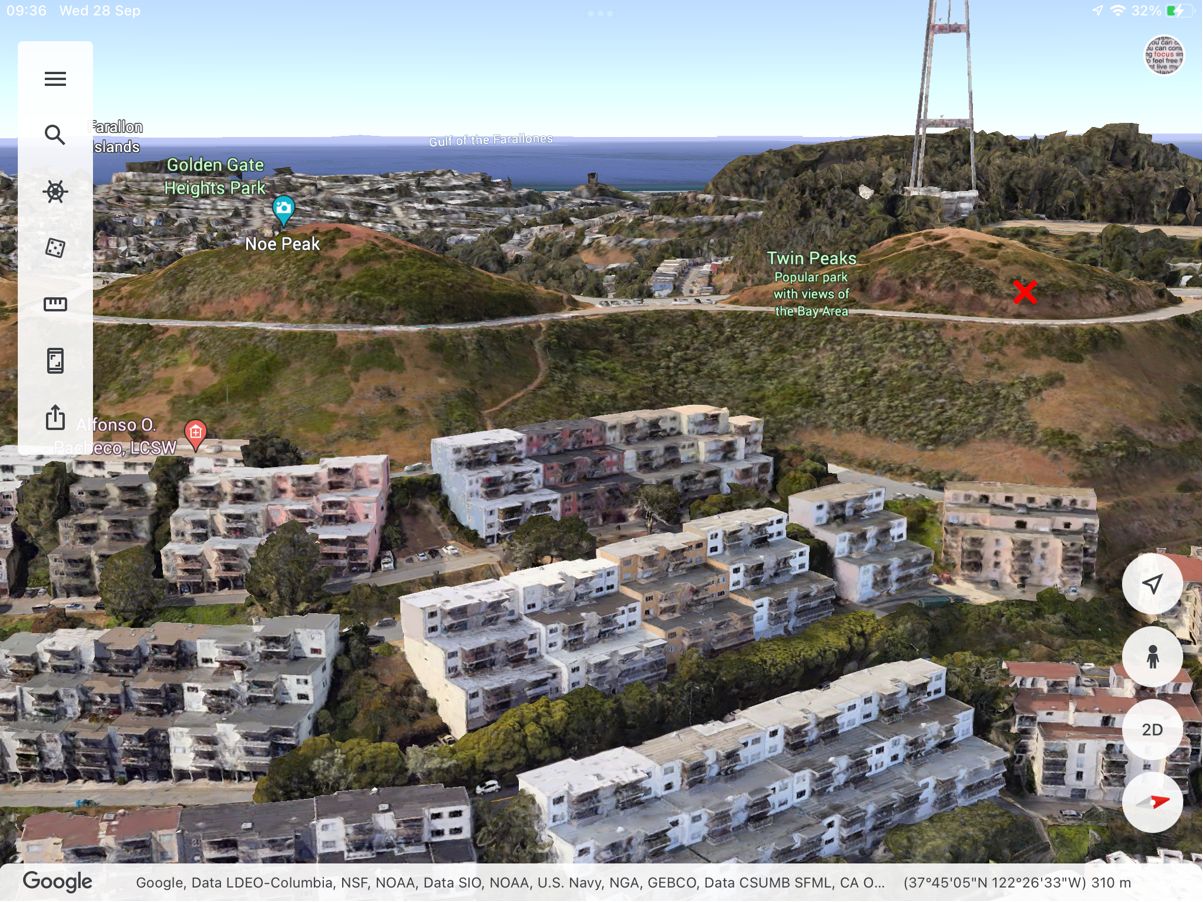
“This isn’t right! It’s not even wrong!”—Wolfgang Pauli (1900–1958)
Having presented for consideration and comment (evaluation) a set of assumptions and a method of attack towards seeking solution of the Z32, I want to just add a final observation about the actual example that was used and the location it led to. Having gone over the steps meticulously, I personally have to conclude that this, in itself, has non-trivial merit also. As you have seen, my example put the bomb location on Eureka Peak — the north-aligned summit of the Twin Peaks in central San Francisco.
Necessary to the method and assumptions was the proposition that the Z13 was nothing less than a first attempt to provide the same information that was then attempted a second time with the Z32. Essentially:
“You didn’t get it the first time, let me try again.”
Is it not then plausible that the Zodiac may even have sought to offer one further attempt to give the location, once it became evident that the provision of the Z32 along with the map was still not enough?
Giving provisional candidate status to the solution from this example, it seems plausible that the Zodiac may, in fact, have done just this, in the Halloween Card, only this time much more directly.
“You’re not getting this. Let me just give it to you.”
In the attached figure (below), I offer an uncomplicated interpretation of the bottom-right symbols on the Halloween Card that — although prompted from prior knowledge of the outcome of the above example solve — is direct enough (in my view) to lead to the same location on its own.
“Just look for a hill with two peaks on a S-N line (‘N’, in the relevant orientation, not ‘Z’). The bomb is on the northernmost peak, facing east.”
The four dots present depth perspective (top two smaller, and closer together) — foreground and background, essentially conveying “the line figure stands up in the middleground” — and serve merely to mark the quadrants defined by the four cardinal directions of the compass, the extra line under the peaks pulling out the ‘NE’ quadrant specifically.
And of course, after having grown in murderous confidence from the secluded isolation of his early kills to that of Stine in the heart of the city, I cannot suppose for one moment that the Zodiac would expect the search for his bomb location (a twin-peaked hill or mountain) to be focussed anywhere other than in San Francisco.
Whether there are potentially other elements of the additions on the Halloween Card that are indirectly referencing the bomb and its specific location is debatable. For example, it could be argued that the eyes on the card are intentionally directing our attention to the figure and symbols in the bottom right, which we have interpreted here as independently giving the location of the bomb. Perhaps they are even indicating the correct direction along which to view the peaks to understand the apparent ‘Z’ as actually ‘N’ for North.
Such potential intentions can never be decided. However, there is one possible reference that is presented through the one eye peeking out from the hole in the tree that may have more merit as such, although the great likelihood is still that this is just a prime illustration of confirmation bias. This is shown in the image below.
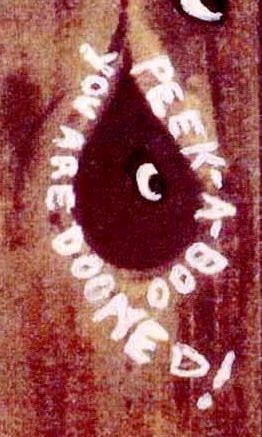
The text, written around the outside of the hole in the tree in a fashion so as to require reading with the card quarter-turned (viewing along the direction of the eyes), reads:
“PEEK-A-BOO YOU ARE DOOMED!”
It is also noticeable, however, that the ‘M’ of ‘DOOMED’ is rendered somewhat larger than the preceding letters, and the same can be said for the subsequent ‘E’.
As to the ‘M’ itself, it’s position is such that it is tightly abutted by the end of the first part of the text at this point, whilst the second part runs on beyond the hole. Although thereby incurring a necessary relative rotation, it’s not hard to see the ‘M’ completing ‘PEEK-A-BOOM’, possibly to hint at its phonetic counterpart:
“PE[A]K [K]ABOOM!”
Further, the ‘M’ is rather ambiguous and, in combination with the following enlarged ‘E’, would almost certainly be read as ‘NE’ in isolation.
“This isn’t right! It’s not even wrong!”—Wolfgang Pauli (1900–1958)
Additional (speculative)
For whatever reason, the Zodiac introduced into the cipher symbol set for the Z13 two stand-out novelties. Firstly, he introduced the only instance of a symbol that could be said to be among those representative of the twelve zodiacal signs, that for Aries. This appears inverted, and a potential explanation for its inversion has been given above.
The second novelty is what I have loosely termed the three-times repeated ‘8-ball’ symbol. Now, this symbol has alternatively been taken to be an encircled Taurus symbol, and this interpretation does indeed have merit of itself. If for nothing else, Aries and Taurus together are adjacent in the sequence of zodiacal signs and, were we to seek the next after Taurus, we would find Gemini.
On the ‘8-ball’ interpretation, however, this would — like with the inverted Aries — be the first time that the Zodiac had included a symbol that was inherently numerical. It has been noted above that this could be by way of indirectly referencing Gemini at a bearing of “8 signs.”
Another, looser, interpretation however is that it has specific reference to the topography of the location, once identified. Specifically, the ‘figure of eight’ of the road around the Twin Peaks, along the north-east section of which it has been conjectured that the bomb is intended to be placed.
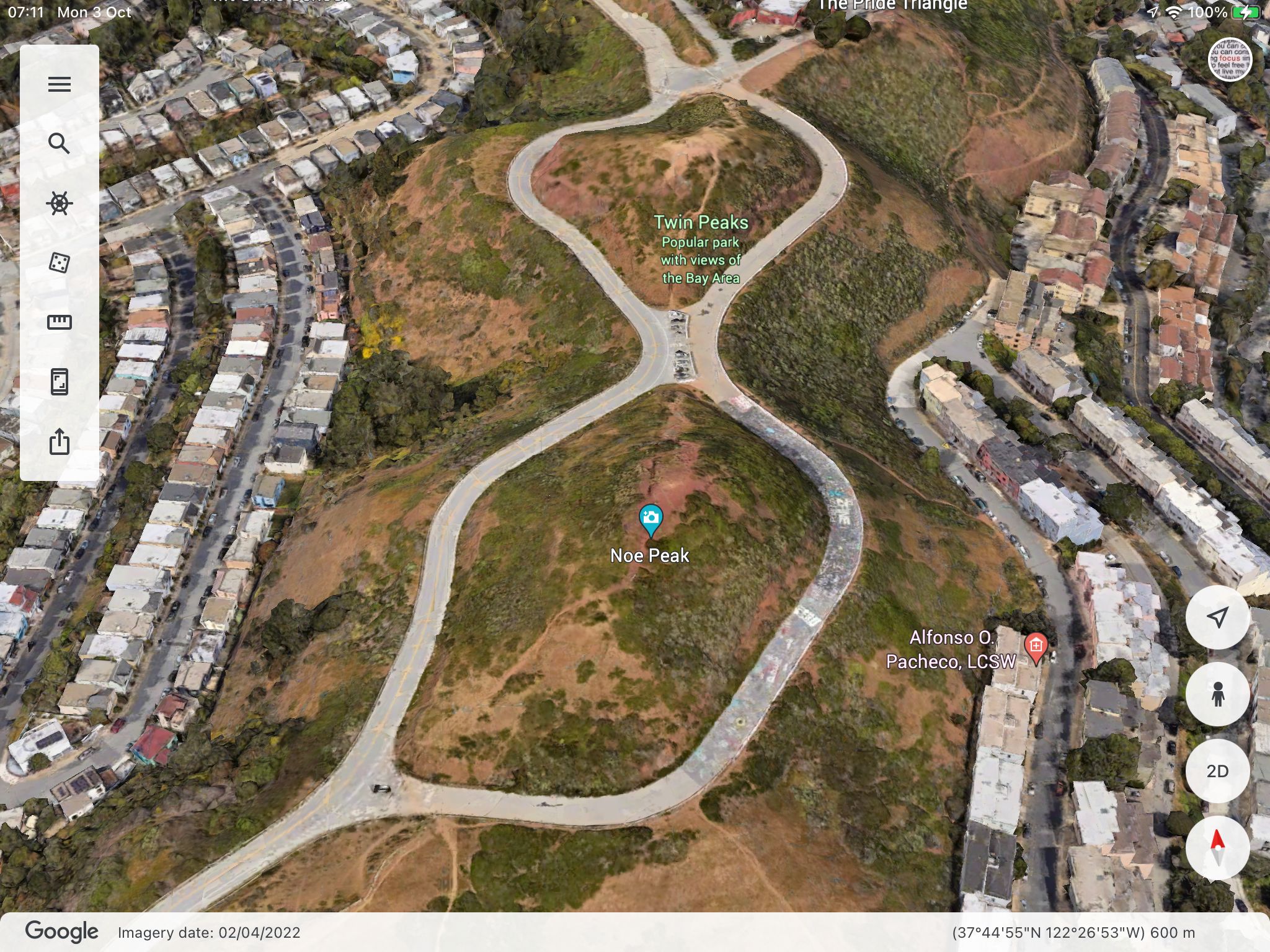
On any reasonable assessment, of course, such observed associations as this can never rise in merit above “likely coincidental,” and I would certainly not want to offer it here as anything beyond a curiosity only.
“This isn’t right! It’s not even wrong!”—Wolfgang Pauli (1900–1958)
An observation
The following is noted merely as an observation at this point, but one which would be worth giving some consideration to as to whether there is anything here that, of itself, may add weight to the initial assumption of treating the Z13 and the Z32 as deriving from a single cipher key.
As its name implies, the Z32 is 32 characters in length, having three cipher characters which are duplicated once each, giving a total of 32 – 3 = 29 distinct cipher symbols. The Z13, on the other hand, has 8 distinct cipher symbols, of which 5 are present in the Z32 also. Thus there remain 3 distinct symbols in the Z13 that are not also in the 32, bringing the total of unique symbols over the two ciphers combined back up to 29 + 3 = 32.
Whether or not there is any relevance to this fact is a question to return to after a period of thought.
“This isn’t right! It’s not even wrong!”—Wolfgang Pauli (1900–1958)
Whether or not there is any relevance to this fact is a question to return to after a period of thought.
So, after some thought, the only potential point of interest that I can currently identify would occur if it were possible to demonstrate an initial intention — or attempt — for the Z32 to be comprised solely of 32 unique, non repeating cipher symbols, upon which the duplicates were later added.
As it turns out, we can get close to this possibility, but not close enough.
Two of the three symbols in the Z13 which do not occur in the 32 — the ‘N’ and the ‘8-ball’ — correspond, in plaintext, to two of the symbols that are duplicated in the 32. Thus, if in the Z32 we were to swap one of the ‘C’s (cipher text) for ‘N’, and one of the open triangles for the ‘8-ball’, then we would have thereby removed two of the three duplicates in the latter without causing any injury to the key as it is.
This is not, however, possible in seeking to remove the duplication of the ‘O’s in the 32, as the last remaining cipher character that occurs alone in the Z13 would be the ‘K’, corresponding to plaintext ‘N’, whilst we would be needing it to correspond to plaintext ‘S’ in the 32.
“This isn’t right! It’s not even wrong!”—Wolfgang Pauli (1900–1958)
So, after some thought, the only potential point of interest that I can currently identify would occur if it were possible to demonstrate an initial intention — or attempt — for the Z32 to be comprised solely of 32 unique, non repeating cipher symbols, upon which the duplicates were later added.
As it turns out, we can get close to this possibility, but not close enough.
For the sake of completeness, and at the expense of just one stretch, the following is offered as a hypothetical scenario of the kind that could support the idea that the Zodiac initially toyed with having the Z32 comprise a cipher composed of wholly unique symbols. Note that, for this to be the case, the assumption here has to be that the Zodiac was working on both the Z13 and Z32 at the same time, to the same purpose, and that his primary and initial focus was on the later-published 32.
Suppose that the proposed cipher solution for the Z32 is as this thread has it and that, initially during the process of encoding, the Zodiac produced a ciphertext having no repeat ciphers at all. As there are three once-duplicated symbols in the cipher as we actually have it, we only need to introduce three changes to model this. A considered example of such a reversal to all-unique symbols is given in the figure below (top).
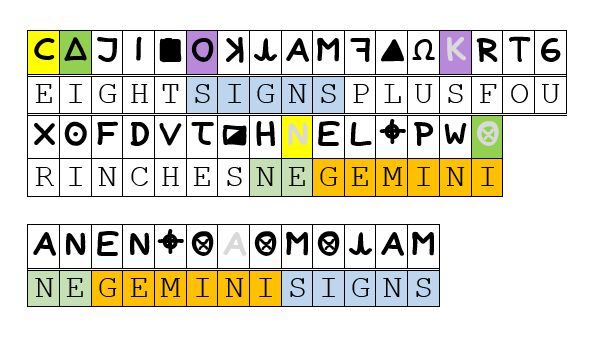
Correspondingly, with the one change made in the Z13 to compensate that we have usurped the original ‘K’ (cipher) for use in the 32 as encoding a different letter (‘O’), we now have a fully unique Z32 (no repeats) and a Z13 that is now comprised solely of cipher characters from the 32, with no originals and exhibiting only one use of homophones.
In the Z32 (top) the three changes to the cipher symbols are in grey, and the colour coding for where the Zodiac will want to form duplicates remains.
Likely, it would be at this point that we would have to assume the Zodiac realised that, of itself, the Z32 cannot stand like this and be open to solution.
So, as the next step he begins to think about adding in a few aids through duplication of symbols, and it has to be proposed in this example that some attempt was made, as far is this was possible, to alternatively indicate the beginning and end of the plaintext words.
As per the analysis throughout this thread, however, it is proposed that very specific attention would have been paid to the duplication of the final ‘I’ through the second letter of the cipher. As noted, this is one of the key instances of “helping through intentionally introducing constraints,” and an ‘I’ at the end of a word is a significant constraint.
Following this through, then, and it is evident that the Zodiac can easily obtain duplicates for the yellow-highlighted symbols without, at the same time, reducing his key set from 32 symbols. The ‘N’ for ‘E’ substitution is already present in the Z13, so nothing is lost through replacing ‘N’ (cipher) with ‘C’ here. And the same is trivially the case with the green-highlighted duplicates, so that the final cipher symbol can become the open triangle without loss to the total key.
For the final pair — the purple-highlighted duplicates — there would, however, be some loss to the key if the cipher ‘K’ were merely switched for ‘O’ to afford the duplication. In this once-adjusted model, the ‘K’ would now be lost to the key altogether and the key itself now one short.
In this scenario, then, it is the one stretch from the beginning that allows the proposition that the Zodiac reintroduces the ‘K’ back into the Z13, not as a homophone for ‘S’, but now for ‘A’, dropping it right in the centre of the plaintext-aligned 32.
It might then be at this point that the Zodiac came to notice the considerable potential for symmetry in the 13 and effected the single shift of the second symbol (‘N’) up to third from the end.
“This isn’t right! It’s not even wrong!”—Wolfgang Pauli (1900–1958)
Evaluation I
As a starting point in evaluating the method of attack on the Z32 proposed in the first post, the following can kick that off through offering an analysis of how the method impacts the constraints imposed on the solution. Recall, it was proposed that solution of the Z32 should be progressed alongside that of the Z13, on the assumption not just of a common key, but of the two ciphers actually duplicating the same intent through use of the precise same words in two, possibly even three, places.
Firstly, then, for this to be a non-trivial assumption — in the sense that it is not merely possible to arbitrarily introduce all and any potential candidate words in the 32 and have them work in the 13 by default — we are going to have to see clear indication that the requirements of the Z13 itself, as to constraints, carry over into the Z32 in a significantly limiting way.
Beginning with the Z32 on its own, the following figure merely highlights the constraints imposed internally.
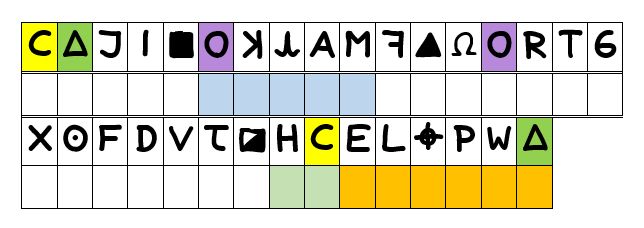
We see, across the upper of each of the paired lines (cipher text), colour-coding showing that there are cipher symbol duplications for three symbols only, coloured here yellow, green and purple. Within the lower lines (plaintext) the colour coding shows where, by our assumption, we are expecting to find words that are duplicated wholly in the Z13.
If, then, these were the sole constraints, then we would be only quite trivially limited in proposing candidates for the three shared words, with little support thereby for the validity and usefulness of the assumption which we started with. In fact, in relation to these three words in isolation, the Z32 of itself provides no constraint that creates any dependence between them and we therefore are unhelpfully granted effectively unlimited freedom to explore candidates.
But this, however, is not the end of the matter, as there are internal constraints in the Z13 that must be brought over and integrated with those internal to the Z32. And when we do this, we are suddenly presented with a very different picture. The next figure aims to illustrate this.
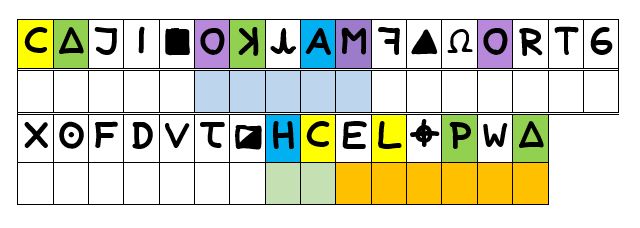
All of a sudden we are now faced with significantly extended constraints to the 32 beyond those that were present internally. As to the three proposed shared words, these extra constraints can be pulled out and identified as follows:
- 5-letter word (blue)
- Now, we are required to have the first and the final letters the same;
- The second letter must be the same as that at both the 4th and 6th position of the 6-letter word (orange);
- The second letter must likewise be the same as the second letter of the cipher as a whole; and
- The fourth letter must be the same as the first letter of the 2-letter word (light green)
- 6-letter word (orange)
- The 4th letter must be the same as the 6th, and these the same as the 2nd letter of the 5-letter word (blue); and
- The second letter must be the same as the very first letter of the cipher, and also the 2nd letter of the 2-letter word (light green)
- 2-letter word (light green)
- This word is now wholly constrained by whatever candidate words are chosen for 1. and 2. above, without freedom in any degree.
So, as I think can be clearly seen, in the event that candidate words are selected such that the above constraint criteria are met, whilst at the same time the whole provides a comprehensible and meaningful plaintext solution, then whatever merit is attributed to it as a potential (plausible) candidate solve must be significant.
“This isn’t right! It’s not even wrong!”—Wolfgang Pauli (1900–1958)
So, as I think can be clearly seen, in the event that candidate words are selected such that the above constraint criteria are met, whilst at the same time the whole provides a comprehensible and meaningful plaintext solution, then whatever merit is attributed to it as a potential (plausible) candidate solve must be significant.
And, just to give a clear sense of exactly how powerful the combined constraints here can be, note the following, which I have no doubt, in this instance, would have to be considered wholly intentional:
That just through the one plausible introduction of the number ‘EIGHTSIGNS’ at the very start of the cipher and nothing else — consistent with a bomb location somewhere in the direction of San Francisco — the last 6-letter word of the Z32 is already all but constrained to matching ‘_ E _ I _ I’, of which there are basically no other genuinely plausible alternatives to ‘GEMINI’.
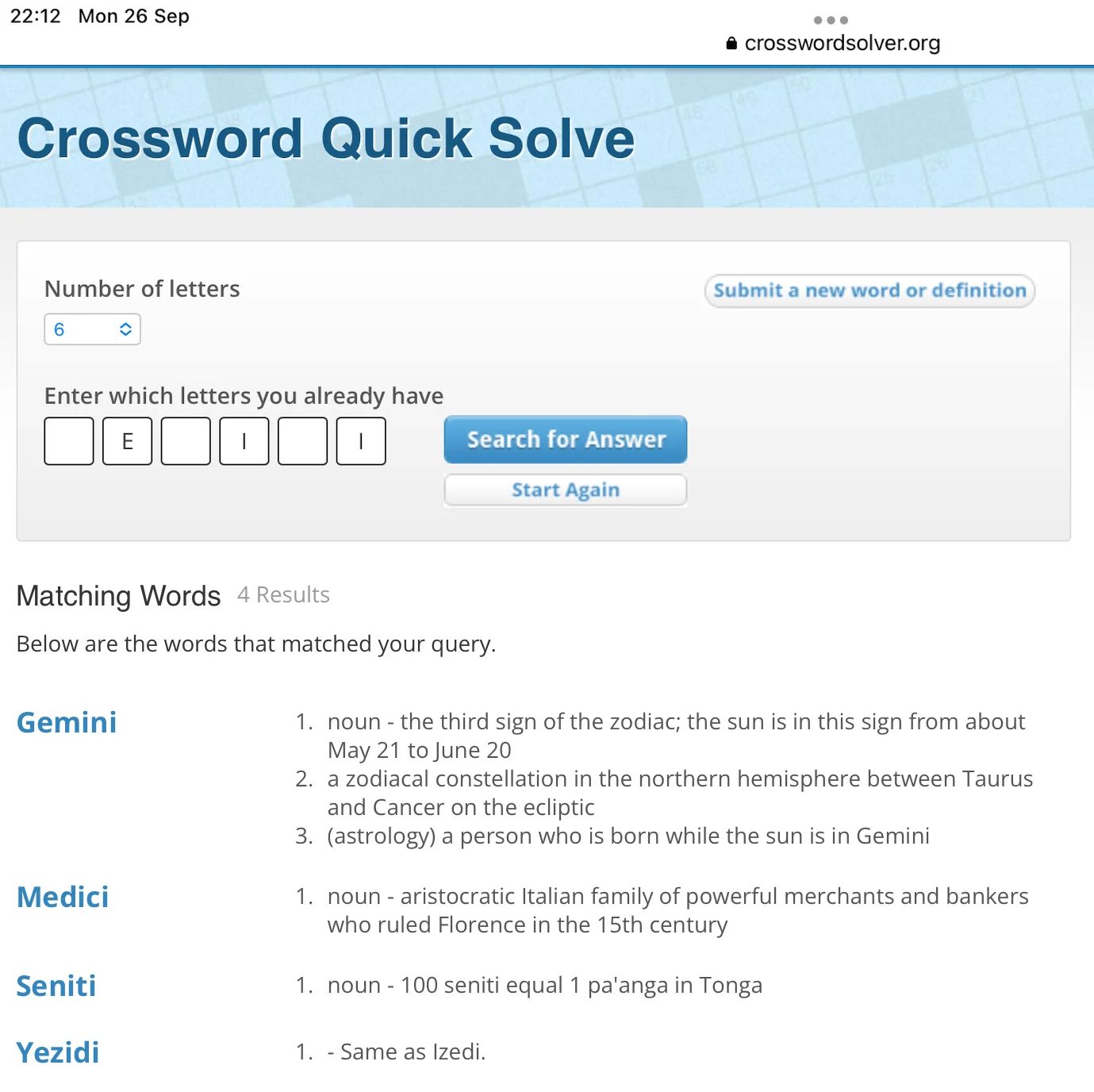
Alternatively, if we were to try the only two other 5-letter numbers at the beginning — ‘THREE’ and ‘SEVEN’ — we would find that the last word, on ‘_ T _ H _ H’, would have zero possible matches, whilst for ‘_ S _ E _ E’ we would have to choose from one of ‘ASWEVE’, ‘ESSENE’ or ‘OSSETE’. Likewise, for ‘SEVEN’, the 2-letter word would be ‘NS’, which would appear meaningless in any plausible context, let alone as preceding any of these three obscure words. Further, we would lose ‘SIGNS’ in both instances.
“This isn’t right! It’s not even wrong!”—Wolfgang Pauli (1900–1958)


